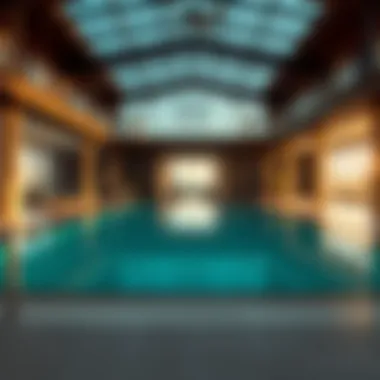Comprehensive Guide to Swimming Pools and Their Benefits


Intro
When one envisions a swimming pool, thoughts often drift to sunny days, family gatherings, and the soothing blue waters waiting to offer respite from the Dubai heat. However, underneath this idyllic scenario lies a world of intricate details—design choices, maintenance requirements, and investment potential that can significantly impact homeowners and prospective investors.
Swimming pools aren't merely luxuries; they are strategic assets that can enhance property value, provide health benefits, and create engaging social hubs. This guide serves to unravel the complexities surrounding pools, aiming to equip readers with the knowledge necessary to navigate the waters of pool ownership in the context of Dubai's vibrant real estate market.
From exploring the various categories of swimming pools to discussing the essential upkeep and safety measures, we’ll delve into factors that not only influence personal enjoyment but also financial implications. Whether you’re contemplating a splash in the real estate market or simply wish to enrich your property’s allure, understanding swimming pools can offer you an advantage—and possibly, a refreshing dip into your next investment strategy.
Preface to Swimming Pools
Swimming pools have become a staple of residential and commercial properties alike, serving both leisure and aesthetic functions. For homeowners, a pool is not just a means to cool off during the summer; it provides a sanctuary for relaxation, a place for social gatherings, and an extensive array of health benefits. On the other side, investors eye pools as appealing features that can greatly enhance property value, particularly in warm climates such as that of Dubai.
The importance of understanding the various aspects of swimming pools is fundamental for anyone considering installation or investment. From design preferences to maintenance requirements, grasping these elements can influence both immediate enjoyment and long-term satisfaction. In this guide, we will unpack the historical context, types of pools available, and their respective advantages, helping you navigate through the breadth of options at your disposal.
Historical Evolution of Swimming Pools
The journey of swimming pools stretches back to ancient civilizations, where the essence of water surrounded culture and daily life. The earliest records trace back to the Indus Valley Civilization, dating as far back as 2500 BCE, where large public baths signified not only bathing but also a communal gathering space. Fast forward to the Roman Empire, where swimming pools became elaborate architectural feats, reflecting both opulence and engineering prowess.
As centuries passed, the evolution continued; the Renaissance period saw the introduction of private pools amongst the elite, adorned with marble and sculptures. This trend maintained its foothold, gradually making inroads into more accessible designs since the mid-20th century with the advent of less expensive materials and widespread suburban housing development. Today, swimming pools have diversified into various types suited for different aesthetic preferences and budgets, making them more accessible than ever.
Types of Swimming Pools
Swimming pools can be broadly classified into several categories, each catering to different needs, preferences, and environments. Here we’ll explore four prominent types:
In-ground Pools
In-ground pools are the quintessential choice for many homeowners, offering a seamless integration into the landscape. They can be constructed using concrete, fiberglass, or vinyl, providing a range of aesthetic possibilities.
Key characteristic: Durability and customization. In-ground pools provide unparalleled longevity. Homeowners appreciate that these pools can be tailored in size and shape, which means they can be designed to fit seamlessly within any backyard space.
Advantages: The customization aspect allows for unique features like vanishing edges, waterfalls, and integrated lighting.
Disadvantages: However, they often come with a higher initial cost and longer installation periods, which can be a barrier for some buyers.
Above-ground Pools
Above-ground pools offer a more budget-friendly option, typically assembled using a prefabricated material that sits above the ground level.
Key characteristic: Affordability and ease of installation. Without the need for extensive groundwork, above-ground pools can usually be set up in a matter of days, making them ideal for those who want a quick solution.
Advantages: This type of pool requires less maintenance and is easily removable, so it's a great choice for renters or short-term homeowners.
Disadvantages: Climbing into an above-ground pool can be less elegant compared to the in-ground alternatives. They often come with limited design options as well.
Infinity Pools
Infinity pools offer a luxurious feature by creating a visual effect of water extending beyond the boundaries of the pool itself.
Key characteristic: Spectacular aesthetics. Typically designed to overlook a view, infinity pools can transform a standard backyard into a resort-style retreat.
Advantages: The breathtaking views and attractive design significantly enhance property value.
Disadvantages: However, they tend to be on the pricier end and require a unique landscape design to be effective.
Koi Ponds
Unlike traditional swimming pools, koi ponds serve as both an aesthetic focal point and a habitat for living fish. This type of water feature is intricate, requiring careful design to maintain a healthy ecosystem.
Key characteristic: Natural beauty and tranquility. Koi ponds can nestle into gardens, providing a calming ambiance, perfect for relaxation or meditation.
Advantages: They encourage biodiversity and can be quite stunning when well-maintained.
Disadvantages: Maintaining water quality and ensuring the right environment for the koi can be demanding in terms of effort and resources.
In summary, understanding the various types of swimming pools available allows prospective buyers or investors to make informed decisions aligned with their lifestyle, preferences, and investment goals.
Design Considerations for Homeowners
When it comes to adding a swimming pool to your property, it’s not just about diving into the water. There’s a whole lot more that goes into it, especially for homeowners looking to make informed choices. Design considerations stand at the very forefront of this decision-making process. Properly assessing the design can shape not just the aesthetic appeal of the pool but also its functionality and usability. This section addresses critical aspects that every homeowner should ponder when contemplating their backyard oasis.
Choosing the Right Location
Sun Exposure
Sun exposure plays a substantial role in the enjoyment and utility of a swimming pool. If you place your pool in a sunny spot, it can be a delight during warm months, drawing families and friends together for some quality outdoor time. Optimal sun exposure not only warms the water naturally but extends the swimming season, making it a favorite choice among homeowners. A unique feature of sun exposure is that it can help reduce heating costs substantially. However, one must tread carefully; too much sun can lead to overheating water, which can be uncomfortable for swimmers.
Privacy


Privacy is what turns a good pool experience into a great one. Many homeowners want to swim without onlookers peering from over the fence or neighboring yards. The right landscaping or barriers can create a secluded ambiance that allows for relaxation and peace. The character of privacy ensures that families feel comfortable using their pool without inhibitions. That said, it’s crucial to strike a balance; excessive barriers may create a cramped feeling, and homeowners should ensure that any privacy solutions still allow for adherence to local building codes.
Accessibility
When thinking about where to plant your pool, consider accessibility. A well-placed pool should be easy to access from the main house, allowing for spontaneous swims without the hassle. The design aspect of accessibility contributes not just to the enjoyment but also to safety, especially for kids or elderly family members. A unique feature to consider is the inclusion of ramps or steps that bridge the gap between the pool and the surrounding area. On the flip side, creating easy access points may impact aesthetic decisions, so it's about finding that sweet spot.
Pool Size and Shape
Standard Shapes
Standard shapes such as rectangular or circular pools are often popular for a reason. Their uniformity can accommodate straightforward installation processes and ensure that maintenance is manageable. The key characteristic about these shapes is that they provide a classic look that fits many designs. The advantages range from easier cover options to simple lining replacements. However, sticking with standard shapes means that uniqueness might be sacrificed; it can also limit how the pool integrates into its environment.
Custom Designs
For the adventurous homeowner, custom designs might just be the ticket. Whether it’s a free-form style that twists and turns like a river or a geometric wonder with unique angles, custom designs allow for a highly personalized touch. Having this flexibility appeals to those who view their pool as not just a place to swim, but as part of the home’s character. Though they offer remarkable benefits like adaptability to your landscape, maintenance might be a little trickier, and costs can climb steeply.
Space Optimization
Space optimization is crucial for homeowners measuring their property accurately. It’s all about making the most out of what you have. A wisely optimized space can ensure that your pool feels spacious, without crowding out other yard elements. The unique feature here revolves around utilizing features like landscaping to provide a flowing feel. Yet, prioritizing too much on space without regards to comfort can make the area feel cramped, so it’s essential to find an approach that harmonizes everything in your yard.
Material Selection
Concrete
Concrete pools are celebrated for their durability and flexibility. Homeowners often gravitate toward concrete owing to its strength and ability to mold into any shape desired. This material choice can be particularly beneficial for custom-designed pools, lending them a certain permanence. However, owners should be aware that while concrete is rugged, it can require more upkeep and takes longer to install.
Fiberglass
Fiberglass pools tend to catch the eye of many due to their ease of installation and lower maintenance needs. The key characteristic of fiberglass is its smooth surfaces, which can deter algae growth, keeping the pool cleaner overall. Homeowners can enjoy the advantage of quicker installation times. On the downside, fiberglass pools come in limited shapes and sizes, so it may not fit every homeowner’s dream agenda.
Vinyl Liner
Vinyl-lined pools are renowned for being budget-friendly. They allow for a variety of styles and can be replaced as needed. The real appeal lies in their affordability, especially for those looking to enjoy the pool without overspending. That said, the unique feature of vinyl is its vulnerability; over time, liners can rip or fade, and replacement is a must, leading to additional costs down the line.
Natural Stone
For the aesthetic-minded homeowner, natural stone pools are often the cherry on top. With a natural appeal that meshes well with organic landscapes, this choice can enhance the overall allure of the backyard. However, while they can create stunning visuals, they often come with a heftier price tag and complications in installation. The maintenance can also be more involved, and homeowners must consider if that aligns with their long-term goals.
"Choosing the right design for a swimming pool is more than just aesthetics; it’s about functionality, comfort, and suitability for your property."
As we dive deeper into understanding swimming pools, these design considerations provide a clear road map for homeowners, ensuring that every inch of their new backyard feature is perfectly tailored for enjoyment and relaxation.
Construction Process
The construction process of a swimming pool is not just about digging a hole and filling it with water. It is a detailed sequence that requires thorough planning, precise execution, and adherence to regulations. Each step plays a pivotal role in ensuring the longevity, safety, and enjoyment of the pool. Understanding this process helps homeowners and investors alike to appreciate the intricacies of pool installation, making informed decisions along the way.
Planning and Permits
Getting your ducks in a row is crucial before you even think about breaking ground. The planning stage includes determining the pool's location, size, and type. But that's not all. Many municipalities require permits to ensure that the construction adheres to safety standards and property regulations.
Consideration of local laws is paramount. Engaging with local authorities early can save a mountain of headache later in the project. This aspect ensures that future homeowners are not facing fines or costly modifications due to non-compliance with regulations. Also, having a well-thought-out plan helps in budgeting for unexpected expenses.
Excavation and Foundations
Once the groundwork has been laid in terms of planning, it’s time to dig in—literally. Excavation is where the shovel hits the dirt. The foundation is essential as it provides the structural integrity that a pool demands. It often involves grading the land to create a level area that can support the pool.
During this phase, contractors will assess the soil type, drainage conditions, and any existing utilities buried underground. This attention to detail ensures that the base is solid and can support the weight of the water, plus the activity of swimmers for years to come. By the end of this stage, you have the outline of the pool, ready for the installation of crucial system components.
Installation of Pool Systems
Putting in the actual pool is just the beginning of the fun. Once the excavation is complete, the installation of various systems comes next. This step ensures that your pool functions effectively and safely. Let's break down the components.
Filtration Systems
The heart of pool maintenance beats strong through its filtration system. An efficient filtration system is built to remove debris, contaminants, and particles from the water, keeping it clean and safe for swimmers. An oft-chosen type is the sand filter, celebrated for its simplicity and effectiveness.
Key characteristics include easy maintenance and longevity. Since sand filters can last for several years, they’re viewed as a popular choice among homeowners looking for reliability. However, they may require periodic backwashing to remove the collected debris, which can slightly increase water usage. Overall, a robust filtration system is non-negotiable for maintaining crystal-clear waters and healthy swimming conditions.
Heating Options
Adding a layer of comfort is where heating options come into play. A well-chosen heating system can transform a pool from a summer-only facility to a year-round oasis. Options include electric heaters, gas heaters, and even solar heating systems.
Electric heaters are recognized for being user-friendly and efficient in smaller pools, making them a beneficial choice for many. However, they can incur high operational costs in colder months. Solar heating, on the other hand, emerges as eco-friendly and budget-conscious, though installation can be a bit more complex. Weighing these pros and cons helps in selecting the most suitable heating system for your needs.
Lighting Features
Lighting is not just for looks; it's about safety and enhancing usability. Good lighting features allow for evening swims, parties, and creating an inviting ambiance. A popular choice today includes LED lights due to their energy efficiency and longevity.
These lights are customizable regarding color, brightness, and also come in various designs to fit the aesthetics of the pool area. While upfront costs can be higher compared to traditional lighting options, the long-term advantages outweigh the initial investment. This important investment in lighting can truly elevate the swimming experience.
"A thoughtfully designed pool is not just a splash of blue; it's an extension of your home that reflects your lifestyle."


Understanding the phases in the construction process of a swimming pool is imperative for anyone considering this luxurious addition to their property. From planning to the installation of crucial systems, each step plays a vital role in transforming a dream into a reality. The focus on filtration, heating, and lighting provides a comprehensive insight into ensuring that the finished product is both visually appealing and functionally efficient.
Maintenance Requirements
Maintaining a swimming pool is akin to nurturing a living organism; it requires regular attention to thrive. Maintenance encompasses several essential tasks that not only ensure the pool remains clean and aesthetically pleasing, but also prolong its lifespan and safeguard the health of its users. In hot climates, like Dubai, where the heat can be intense, diligent maintenance becomes crucial. Regular upkeep helps prevent costly repairs down the line and maintains the value of the property. The following subsections discuss the key aspects of pool maintenance in greater detail.
Regular Cleaning and Maintenance
Regular cleaning of your swimming pool should become part of your routine, just like mowing the lawn or changing your car's oil. It involves skimming debris from the surface, vacuuming the pool floor, and brushing walls to prevent algae build-up. Not only does this keep the pool looking inviting, but it also minimizes chemical usage and maintains water circulation efficiency. A clean pool not only factors in the appearance but also the health of its users. Over time, neglect can lead to murky water and create a breeding ground for bacteria.
Water Quality Management
Water quality management is vital in ensuring safe swimming conditions.
Testing pH Levels
Testing pH levels of water is a primary step in managing water quality. The ideal pH level for pool water is between 7.2 and 7.8. Maintaining proper pH levels can prevent skin irritation in swimmers and help to keep pool equipment in good condition. A significant advantage of consistently testing the pH levels is that it helps avoid corrosive or scaling conditions. For example, if the level drops too low, it can corrode the metal fixtures, while a high pH can cause scaling. This quick test can save a lot of future expenses by stopping these problems before they escalate.
Chemical Balancing
Chemical balancing encompasses several factors, including chlorination, alkalinity, and calcium hardness. Proper chemical levels balance each other to maintain water clarity and sanitation. For instance, balancing the alkalinity influences pH levels and how effectively your sanitizer works. A well-balanced pool chemical system significantly reduces health risks by limiting harmful bacteria and ensuring that swimmers enjoy a clean experience. Chemical balancing, however, requires some expertise and vigilance- if not done right, it could lead to problems like over-chlorination that can affect skin and eyes negatively.
Algae Prevention
Algae prevention is crucial for keeping the pool inviting and hygienic. Algae flourish in warm environments, which makes pools in Dubai particularly susceptible if not cared for properly. Regular maintenance practices such as shocking the pool and running filtration systems adequately can thwart algae growth. Moreover, utilizing algaecides as a preventive measure not only eliminates existing algae but also inhibits future growth. This proactive approach is wise; it requires less effort in the long run compared to an all-out algae battle once it establishes strong roots in the pool.
Seasonal Considerations
Seasonal changes necessitate specific maintenance tasks to prepare the pool for different weather conditions.
Winterization
Winterization involves safeguarding the pool against damage during colder months. In Dubai, where winters can be mild, the procedure may be more about proper cleaning and less about freezing damage. Closing the pool for winter often includes lowering the water level, adding anti-freeze agents where needed, and securing a cover. This process ensures that when swimming season comes back around, the pool is ready to jump right into; it’s also a time-saver because it prevents buildup of dirt and debris that could mar initial opening routines.
Covering Techniques
Covering techniques vary from winter covers to solar covers. The primary goal of using a cover is to reduce debris accumulation and also regulate water temperature. Schlieping a cover over the pool can significantly decrease evaporation, thus maintaining the chemical balance of the water. Investing in a good-quality pool cover may require a higher upfront cost but can cut down long-term cleaning and chemical costs substantially. Moreover, covers also enhance safety by preventing accidental entries from pets and children.
Equipment Checks
Regular equipment checks involve the assessment of pumps, filters, and heaters. This step is important because worn-out or malfunctioning equipment can lead to more significant issues. For example, a dirty filter won't effectively circulate water, leading to increased algae growth. Checking these components regularly not only ensures optimal equipment performance, but can also prevent more serious breakdowns which may lead to higher repair costs. Scheduled checks can save headaches and budget pressure later.
"An ounce of prevention is worth a pound of cure."
By maintaining a schedule for regular cleaning, water quality management, and seasonal preparations, pool owners can create a safer swimming environment and extend the life of their investment.
Health and Safety Aspects
When it comes to swimming pools, understanding the health and safety aspects is crucial. Not only do these elements protect individuals using the pool, but they also ensure peace of mind for homeowners. A well-designed swimming pool contributes to health benefits, but it may also pose dangers if adequate safety measures are not in place.
Health Benefits of Swimming
Cardiovascular Health
Swimming is a fantastic way to boost cardiovascular health. It’s a low-impact activity that engages multiple muscle groups and helps maintain a healthy heart. Research indicates that regular swimming can lead to lower blood pressure and improved circulation. This contributes to a more robust heart health and also aids in weight management, making it a stellar choice for anyone looking to enhance their physical well-being without placing excessive strain on their joints.
The unique feature of swimming is its dual benefit of being both an aerobic workout and a soothing activity. It combines exercise with relaxation, which both aids heart function and alleviates the impact of stress. However, it is vital to ensure that individuals swim within their skill level to avoid exertion, which could have adverse effects.
Muscle Toning
Muscle toning is another exciting aspect of swimming. The resistance water provides allows for a full-body workout, engaging the muscles in ways that land exercises may not. Each stroke can enhance muscle strength while improving flexibility. For individuals seeking to tone their bodies, swimming presents a compelling option.
The water’s buoyancy supports the body, making it a non-straining exercise choice, especially for those recovering from injuries. On the downside, without proper techniques and guidance, one may not achieve the desired results in muscle toning as effectively. Therefore, it’s advisable for new swimmers to consider lessons.
Stress Relief
Swimming stands out as an exceptional means of stress relief. The act of gliding through water can have a calming effect, while the rhythmic nature of swimming can induce a meditative state. Many people find that spending time in the water allows them to disconnect from daily stressors. This emotional benefit can play a significant role in overall mental well-being.
Additionally, engaging in activities like swimming can trigger the release of endorphins, commonly known as feel-good hormones. This unique feature makes swimming not just a physical activity but an important mental health tool as well. However, relying solely on swimming for stress relief might overlook a comprehensive approach that includes other healthy habits.
Safety Measures Around Pools
Barrier Requirements
Establishing solid barrier requirements is a crucial safety measure around pools. These barriers serve to prevent unsupervised access to the pool area, especially from children or pets. Installations like fences with secure gates or barrier walls can significantly reduce accident risks when properly designed.
The key characteristic of such barriers is their ability to restrict access while still allowing visibility into the pool area. This transparency is vital for parents or caregivers who want to supervise children while ensuring safety. But while barriers greatly enhance safety, they need to be regularly checked for maintenance; otherwise, their effectiveness could diminish over time.


Lifeguard Presence
Having a lifeguard presence ensures another layer of safety in areas such as public pools or even home swimming pools during gatherings. Lifeguards are trained professionals who can respond to emergencies effectively, providing immediate assistance and alerting emergency services if necessary.
Lifeguards can also educate pool users about safety practices and swimming techniques. Their presence promotes a culture of adherence to safety guidelines. However, maintaining a lifeguard can be an additional cost for pool owners seeking thorough safety protocols, and it may not always be practical for private pools.
Emergency Procedures
Lastly, establishing comprehensive emergency procedures is vital. Having clear guidelines in place can make all the difference during a crisis. This includes having rescue equipment accessible, as well as knowledge of emergency contact procedures.
The key aspect of having structured emergency procedures is preparedness. This can involve a range of actions, from conducting regular safety drills to ensuring that pool users are briefed on basic rescue techniques. However, without continuous training and practice for those involved, these procedures may falter in an actual emergency, potentially putting lives at risk.
Swimming pools can be a source of enjoyment and health, but safety and health must be the top priority for all users.
Landscaping Around Swimming Pools
When thinking about swimming pools, it's easy to get lost in the design of the pool itself. However, landscaping around swimming pools is just as crucial. A well-planned poolscape can not only enhance the visual appeal but also boost the overall functionality of the area. Homeowners and investors need to appreciate how landscaping ties in with a pool’s aesthetic and practical needs, as it complements the water’s calming effect and invites relaxation.
Designing a Poolscape
Plant Choice
Selecting the right plants around a pool area can make a world of difference. It’s vital to consider plants that not only look beautiful but also thrive in the specific environment. For example, drought-tolerant plants such as succulents or ornamental grasses are favored. These types can handle the heat and benefit from the humidity created by the pool. On the flip side, depending on location and microclimate, some plants might shed leaves or attract pollen—a headache for those who prefer a low-maintenance yard.
Plants should also be chosen for safety, with careful consideration for thorny species that could pose a risk near the water. The right selection enhances the aesthetic side without compromising the enjoyment of using the pool. In essence, a thoughtful plant choice not only beautifies but creates an inviting oasis where relaxation becomes second nature.
Hardscaping Elements
Beyond flora, hardscaping elements play a central role in pool design. These elements include pathways, decks, and retaining walls that provide structure and functionality. Choosing durable materials like natural stone or composite decking offers the pool area a luxury feel while ensuring long-lasting quality. Functionality extends beyond appearance; proper hardscaping can aid drainage, preventing water from pooling in unwanted areas, which is essential given the significant moisture presence.
The layout of hardscape features can influence traffic flow and accessibility. Well-placed patios or loungers around the pool encourage social interaction, giving families and friends space to congregate. Yet, certain hardscaping materials may require additional upkeep. Stone may crack over time, while wooden elements could rot if not treated properly. Thus, homeowners should weigh practical aspects versus aesthetic desires when making choices.
Lighting Effects
Lighting around the pool area significantly enhances nighttime ambiance. Specific lighting effects transform a standard pool setup into something magical. For instance, strategically placed underwater lights can reveal a glimmering effect, showcasing features like waterfalls or steps. Additionally, path lighting directs guests safely, ensuring no one missteps when moving to and from the pool.
Beyond safety, thoughtful lighting choices—like color-changing LEDs or solar-powered lanterns—bring a vibe to evening gatherings. It creates an inviting atmosphere that enhances swimming experiences during twilight hours. However, light placement requires foresight; not all designs translate well under varying night conditions. Improperly illuminated areas could lead to shadows and safety concerns.
Enhancing Aesthetic Appeal
Making the pool area visually appealing can significantly elevate the overall property value. The surrounding landscape sets a mood that can attract potential buyers or renters. For instance, thoughtful integration of greenery, stones, and decorative features ties together the functionality of a poolscape, making it a cohesive, pleasant place to be.
To captivate the discerning buyers or investors, the understanding that landscaping is not merely about aesthetics but also about creating an experience is essential. It’s an investment of time and money that pays off—not just in relaxation on a hot summer's day, but also in making the property itself a much more appealing venture for many in the Dubai real estate market.
Impact on Property Value
When considering the addition of a swimming pool to a property, understanding its impact on property value is crucial. Swimming pools are seen as not just a luxury feature but also a significant enhancement to residential marketability. Homebuyers often view a pool as an indication of a desirable lifestyle, which can be helpful in attracting buyers who are already familiar with the concept of outdoor leisure. This section delves into how pools influence property value, highlighting key elements and the specific dynamics at play in the Dubai real estate market.
Market Trends in Dubai Real Estate
Dubai's real estate market showcases unique trends when it comes to swimming pools. In recent years, the demand for private pools has surged, largely due to the city's hot climate. Here, a well-crafted pool can turn a regular backyard into a sought-after outdoor retreat. With temperature often soaring above 40°C, a swimming pool offers a refreshing escape, making properties with pools more appealing. Properties without this feature can linger on the market longer, which directly affects their value.
The trend also indicates that luxury villas and townhouses, particularly in affluent neighborhoods, often come with specialized pool designs tailored to enhance aesthetics and functionality. This could mean elaborate lighting systems or eco-friendly swimming options that use natural filtration.
Swimming Pools as Value-Add Features
Swimming pools are increasingly viewed as invaluable assets in the residential market, particularly in upscale areas or family-oriented neighborhoods. For property investors and homeowners alike, understanding the following characteristics is essential.
Buyer Preferences
Potential buyers today often show a distinct preference for homes that feature a swimming pool, especially families looking for a private recreational area. The key characteristic of buyer preferences is lifestyle enhancement; many see it as an attractive way to entertain guests or foster family activities at home. The unique feature of incorporating functional designs, such as poolside lounges or cabanas, can significantly enhance this appeal by adding to the home's outdoor living space.
However, not everything is rosy. Some buyers may view pools as a potential liability due to maintenance requirements and safety concerns, particularly if young children or pets are in the picture. This can swing a buyer's interest either way, hence why proper marketing plays a pivotal role in conveying the positive aspects of pool ownership.
Investment Return
When it comes to investment return, a swimming pool can offer remarkable profitability, especially if installed in a property with good potential for appreciation. If the buyer's market favors outdoor living, a pool can positively influence the overall value of a home – translating to a compelling selling point. However, it's essential to understand the costs involved; the installation can be a hefty investment.
An additional point to consider is that the pool's style and maintenance will also play into the potential return. A well-kept pool that aligns with current trends can elevate a home’s value significantly, while a poorly maintained one may detract from it.
Ending
As we come to a close on this comprehensive exploration of swimming pools, it’s pivotal to underscore the significant role they play in residential properties. Not only do they serve as a refreshing retreat during sweltering summers, but they also enhance the aesthetic and functional value of a home. In today's competitive real estate market, particularly in places like Dubai, having a swimming pool can be a game changer. This is due to a few crucial factors.
First, pools contribute to property value. Homes with pools often command higher prices and attract a broader range of potential buyers. Effective landscaping and smart designs can combinedly create an inviting oasis that draws in those aiming for luxury and leisure.
Second, swimming pools provide abundant health benefits. Regular access to a pool enables convenient aquatic workouts, promoting cardiovascular well-being and stress relief, making them an attractive feature for health-conscious buyers. It's not only about aesthetics; it's an investment in a lifestyle.
Additionally, as we’ve discussed throughout this article, the importance of maintenance cannot be overlooked. A well-maintained pool is inviting, while neglect can lead to health hazards and decreased property appeal. Prioritizing upkeep is key to leveraging the full potential of having a pool, making it imperative for homeowners and investors alike.
"A swimming pool isn’t just a hole filled with water; it’s an opportunity for fun, relaxation, and connection with nature."
Finally, as we gaze into the horizon of future trends in pool design, there are exciting innovations on the verge of transforming what swimming pools can be. With an increasing focus on eco-friendly materials, advanced water filtration systems, and smart home integration, the dynamics of pool construction and management are shifting.
In summary, understanding swimming pools extends beyond merely appreciating their aesthetic qualities. It’s about grasping how they integrate into homeowner lifestyles, enhance property value, and adapt to future innovations. This makes being informed a crucial factor for anyone involved in buying, selling, or investing in real estate.







